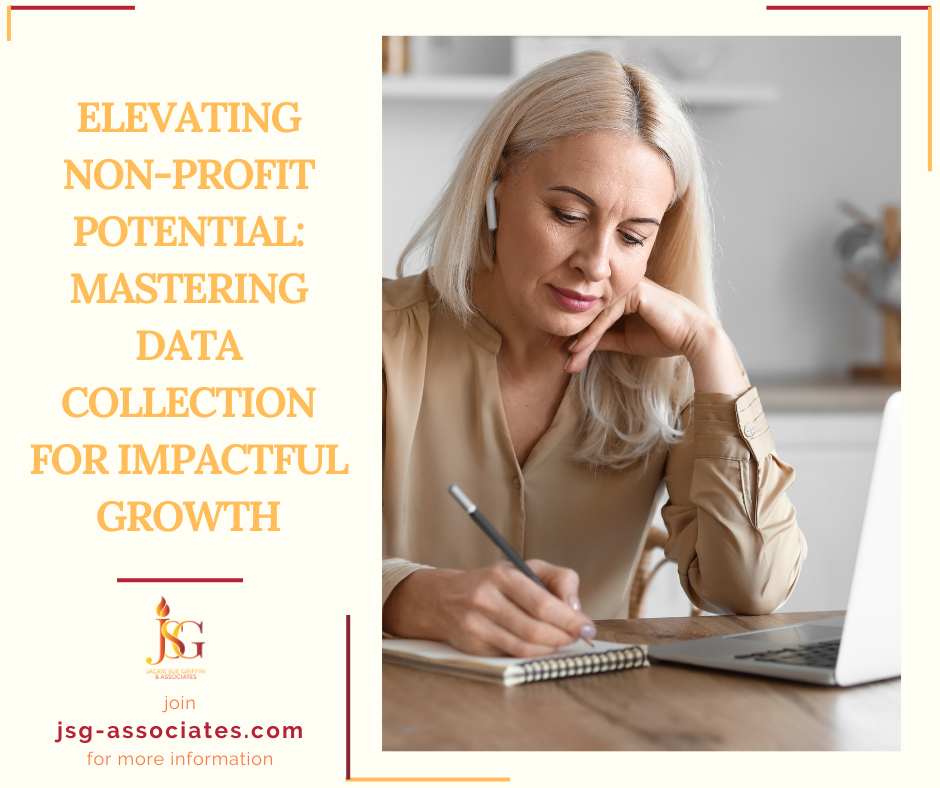
20 Dec Elevating Non-Profit Potential: Mastering Data Collection for Impactful Growth
Written by Jackie Sue Griffin
Capturing data forms the backbone of successful non-profit operations. It involves methodically gathering and recording crucial information about donor interactions, program outcomes, volunteer engagement, and financial transactions. The impact of efficient data collection cannot be overstated for non-profits. It serves as the foundation for informed decision-making, aids in creating effective strategies, and plays a pivotal role in showcasing the organization’s success. By examining critical data points and implementing effective collection strategies, non-profits harness this information to make better decisions and magnify their impact within their communitiesTop of Form
- Understanding the Significance of Data for Non-Profits
Data serves as a valuable source of insights that fuels strategic decision-making within non-profits. Its impact extends across multiple areas of non-profit success, playing a vital role in securing funding, evaluating programs, and fostering stronger connections with donors. By harnessing data effectively, organizations can clearly showcase the tangible outcomes of their initiatives; strengthening support and attracting funding opportunities. Countless success stories exist within the non-profit landscape, already demonstrating the power of data-driven approaches. These stories serve as evidence that data can drive organizations toward their objectives, allowing them understand community needs, tailor interventions, and ultimately fulfill their mission.
- Identifying Key Data Points for Collection
In non-profit operations, certain data points stand out as invaluable. These cover a diverse range of donor details, program outcomes, volunteer engagement statistics, and financial data. Each category holds its own unique significance; donor information encourages lasting relationships and tailoring outreach efforts, while program outcomes serve as proof of impact, generating donor support. Volunteer engagement data acknowledges contributions and identifies opportunities for increasing the number of volunteers who offer their time to your non-profit. Financial data, on the other hand, forms the backbone of budget planning and resource allocation. Through real-world examples, the relevance of these specific data points becomes apparent, along with their role in advancing organizational objectives.
- Implementing Effective Data Collection Strategies
When establishing data collection practices, non-profits can benefit from using several strategies. Specialized software tools and automated data entry can be helpful in improving efficiency and accuracy. When using these tools, create data storage systems for your team to ensure accessibility and facilitate organized data management. Embracing best practices in data collection helps maintain the consistency of the data, ensuring its reliability for decision-making. Addressing challenges within non-profit settings, such as resource limitations or technology barriers, involves finding tailored solutions for your team to optimize the data collection processes. There are a few things to take into consideration when developing these solutions:
Diverse Data Types: Non-profits deal with a range of data types, including donor details, program outcomes, volunteer engagement, and financial information. Employing individual collection methods for each category creates a comprehensive dataset that supports varied organizational objectives.
Stakeholder Collaboration: Involving stakeholders in the data collection process can foster a sense of ownership. Engaging staff, volunteers, and beneficiaries in providing data not only ensures accuracy but also encourages a collective commitment to the organization’s goals.
Continuous Evaluation and Improvement: Regularly analyzing data collection is crucial. Conducting periodic evaluations allows non-profits to identify gaps, consider the effectiveness of strategies, and make much needed improvements, ensuring data practices remain aligned with organizational needs.
- Leveraging Data for Enhanced Decision Making and Impact
Harnessing data within non-profit operations ensures informed decision-making and drives impactful changes. Collected data serves as a compass, guiding initiatives and directing program enhancements. By delving into case studies showcasing successful organizations, we can see the transformative power of data-driven strategies in creating positive change. Moreover, data-driven storytelling emerges as a necessary tool for fundraising and donor engagement, weaving narratives backed by evidence to show the impact of non-profit initiatives, resonating more deeply with supporters and stakeholders.
- Building a Data-Centric Culture within Non-Profits
Establishing a data-centric culture within non-profits requires strategies for demonstrating the significance of data collection and analysis. Encouraging staff involvement and providing training in data collection processes are pivotal steps toward fostering this culture. By showcasing how data utilization benefits different parts of the organization, from enhancing programs to informing decisions, every team member becomes a stakeholder in this approach, reinforcing its value across all levels of the organization. This collective commitment to capturing data empowers non-profits to steer towards more impactful and informed decision-making.
Click here to learn more about how JSG & Associates can help your nonprofit.

No Comments